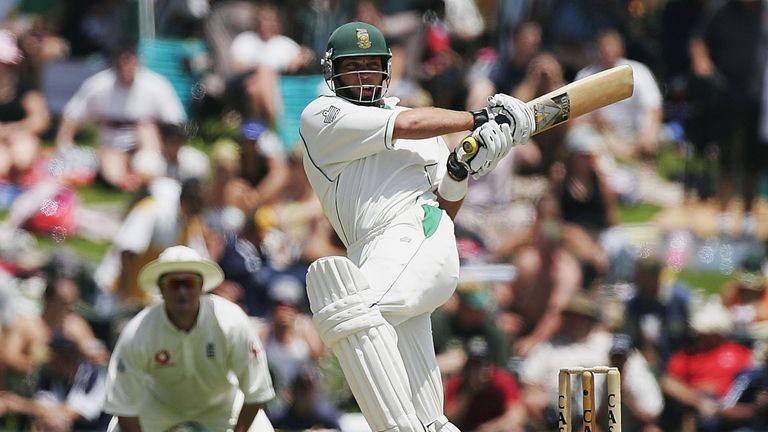South Africa v England: Mike Atherton's guide to Centurion
A ground marked by watershed moments in cricket's history...

Saturday 23 January 2016 11:31, UK
Just 45 minutes' drive from Johannesburg, on the outskirts of Pretoria, South Africa and England will take the field to close the series at Centurion's SuperSport Park. While the ground may not be as imposing as the Bullring, it has marked two contrasting, watershed moments in cricket history.
The 1995 Test marked the first contest between the two countries on South African soil since the ending of apartheid, and it was not the only impression left on Mike Atherton that day.
"I was hit on the head three times in the first morning by Shaun Pollock, who was making his debut," Atherton, chief cricket correspondent of The Times and Sky Sports cricket expert, says.
"They also had a left-arm bowler Brett Schultz, nicknamed 'The Bear' and built like a bull, who came steaming in during his first few overs with lots of short balls. He then limped off with a hamstring strain and we never saw him again. Graeme Hick played beautifully for 141, I was out to the second new ball for 78 - and then it rained for three days."
The Test was preceded by a practice match in Soweto, the first-ever first-class game in the township that provided a fitting stage for the introduction to Nelson Mandela, the recently installed president. He arrived unexpectedly with a motorcade midway through the first morning and strode on to the outfield as the game ground to a halt and the players lined up for a greeting.
"I remember introducing him to Devon Malcolm and Mandela saying: 'You're the destroyer', because Devon had taken 9 for 57 against South Africa at The Oval at the end of the previous summer," Atherton recalls. "That filled Devon with a lot of pride."
Just as in 1995, the return to Centurion for the final Test in 2000 proved a damp affair, but that is where the similarities end. It wasn't just the rainclouds that marked a Test that will forever be darkened by a match-fixing saga involving South African captain Hansie Cronje.
Having rained for three days and with the hosts leading the series 2-0, Cronje and England captain Nasser Hussain agreed to forego an innings apiece to set up a target for the visitors and provide a final day of entertainment for the fans.
"What we didn't know at the time was the inducement for Cronje to do so," Atherton explains. "We weren't sure how the pitch would play after three days of rain so as South Africa continued their first innings, I was sent to act as a negotiator for the target, running off to talk to Hansie until they eventually set us 249 in 76 overs - a very generous target."
England reached it with five balls and two wickets to spare and it was only months later, as Atherton was turning out at Fenner's for Lancashire against Cambridge University, that he heard the Delhi police had tapes of Cronje talking to bookmakers and promising there would be a result.
"The irony was that at the time of the game, the public reaction was that forfeiting innings to make it competitive was a fantastic thing to do," Atherton says. "The series was done and dusted, so it appeared he was doing it for the fans. At eight wickets down, we almost lost, and it gave the spectators something to interest them on the final day they wouldn't otherwise have had. Only later did we find out it wasn't for the right reasons."
The wet weather was back for 2005, when Centurion again hosted the final Test at the end of January. It led ultimately to another tactical declaration for South Africa, but this time by captain Graeme Smith to try and force a series draw. He was denied when his opposite number Michael Vaughan held firm after an early flurry of wickets to leave England 73-4 at the close.
That 2005 Test saw AB de Villiers, aged 20 years and 11 months, become the third youngest South African centurion after Graeme Pollock and Tuppy Owen-Smith, and witnessed the fiery Andre Nel stamp his own mark on the match.
"He was an aggressive character with an on-field alter ego called Gunther," Atherton explains. Nel himself declared that Gunther was a guy who lived in the mountains and was crazy due to a lack of oxygen supply to his brain. "As he marked out his run, he'd write Gunther with the paint and he became a different character. And yes, he was a real character."
Jacques Kallis's 136 not out in the second innings gave him 625 runs for the series to leave him South Africa's leading scorer. Kallis's retirement last year has left a sizeable void that the Proteas are still struggling to fill.
"One thing South Africa are missing is an all-rounder," Atherton says. "It's why De Villiers has kept wicket and it's a problem England had in the past, and why Alec Stewart would take the gloves to balance the side.
"Kallis must go down as one of the greats. He was the lynchpin of that side, whose presence meant South Africa could play four out-and-out seamers and a spinner and still bat deep with Mark Boucher at seven and Pollock eight.
"Ben Stokes in that role is a massive plus for England. To have that extra bowler in Test cricket is vital and Stokes is good enough to bat in the top six. There are not many of them out there. England were strong when Ian Botham and then Andrew Flintoff were around, and Kallis held it together for South Africa for a long time."
Watch continued coverage of the fourth Test between South Africa and England on Sports 2.







